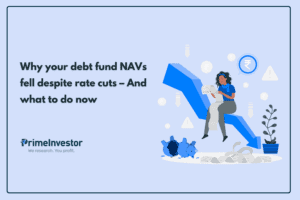Active funds or index funds is a call that continues to remain elusive in the Indian context. While that debate goes on, there is another emerging class of funds – not too active not fully passive. They are quant funds.

Quant funds are rule-based funds, building their portfolios through models that combine a range of metrics and weights to measure a stock’s fundamental strength and valuations to draw up stocks and their allocation in the portfolio.
Globally, this class of funds has grown but has not stood out for any exceptional performance. But then, that is largely to do with how smart global indices tend to be. However, in the Indian context, this space merits some attention, given that the choice of indices is still limited here.
We’re therefore bringing out a series on the quant funds available today, to help you understand these funds. We’re kicking this off with a review of DSP Quant. Please note that this is only a review. Our recommended list of funds and ETFs is available for our subscribers in our Prime Funds and Prime ETFs section.
Why quants?
Before we get to the review, a quick note on the gap quant funds fill. Quant funds straddle the gap between the risk that an active fund turns an underperformer and the risk of losing out on some additional returns in a plain index fund. Generally speaking, these funds should also have a lower expense ratio than active funds, though that currently differs between funds.
- Quant funds are purely data-driven, using different factors, identifying trends, and assigning weights and rules to build a model that has a high probability of beating the index and containing declines better. Models are typically back-tested to see if they work.
- Calls by fund managers are limited to setting rules, providing weights for the various metrics or determining grounds for elimination of stocks. There is no active call done for different market conditions nor is there fund manager preference for specific stocks or sectors.
- You will know the basic principles that the model is built on. This means you will have a steady strategy thus providing a greater degree of predictability on what you can expect.
While there are several positives to quant funds, at this time in our markets, quant strategies are yet to fully take shape and prominence. Quant funds are new and lack any record to judge efficiency of the model. They are best used as a portfolio diversifier with smaller allocations, and not your portfolio’s mainstay at least until they are better established.
Quant funds are being categorised by AMCs under SEBI’s thematic equity category. The quant funds available today are of two types –
- Index based: These funds mirror indices built on quant models (factor-based indices). These indices draw from parent indices such as the Nifty 100, the Nifty 50 etc, and use factors such as low volatility, value, quality equal weight and so on. Prime ETFs, our recommended ETF list features one such index.
- Diversified: These funds use their own quant model to select stocks across the market. They do not mimic any index but generally have an overarching theme to their methodology such as quality or minimum variance.
With that said, let’s get on to the fund we are reviewing in this instalment – DSP Quant.
DSP Quant fund – the basics
DSP Quant was launched in June last year, so it has a limited record. However, the fund has built up a strong AUM at Rs 216 crore. The direct plan’s expense ratio has been at 0.54% for the past few months while the regular plan’s expense has hovered around 1.3%.
The fund aims to have about 30-50 stocks in its portfolio. It picks stocks from the BSE 200 index, giving it a predominantly large-cap bias. Large-cap stocks have made up 85% of the portfolio on an average, with mid-cap stocks averaging 14%. The fund does not appear to take cash calls; from the first month of launch and onwards, cash exposure has been at 1-2%. Whether this exposure will increase later to make room to meet redemptions as size increases remains to be seen.
DSP Quant fund – the model
DSP Quant’s model aims to eliminate weak companies and pick only those that score high on quality and are stable. The model first eliminates companies, using metrics such as a high debt to equity, high price volatility and inability to convert capital and investments into revenues and profits. Using these metrics and elimination does two things:
- One, it mitigates the possibility that a call goes wrong because expectations of a turnaround or improvement do not pan out.
- Two, it removes fundamentally weaker and more volatile stocks which are inherently riskier – even if there is the possibility that they may deliver high returns in a rallying market – which makes the overall portfolio more stable.
- Three, it reduces the size of the investible universe.
At the next level, the model uses performance metrics to measure quality of fundamentals, extent and potential for growth, and the status of valuations. It considers metrics such as cash flows, dividend yields, working capital cycles, pledged shares and so on. Essentially, the model tends to translate into a basic quality theme. Stock weights are decided by the mode’s rules. Sector weights, though, appear to be more or less aligned with the Nifty 200.
While there are increases and decreases in stock weights every month, a major realigning happens once in six months. This sees stocks enter and exit portfolios, allowing the fund to weed out underperformers or book profits systematically.
For example, the fund exited HDFC AMC, GSK Consumer, Sanofi India, Balkrishna Industries, and Shree Cement in March 2020; stocks that delivered good returns. Similarly, the fund exited Bharat Forge, Cummins India, IndusInd Bank, Hindustan Zinc, Tata Chemicals, Emami, and others early on in October last year which have been hit hard in this correction.
Of the stocks that feature in its portfolio now, the fund has systematically built up exposure in most of them. Stocks such as Pidilite Industries, Asian Paints, HDFC Bank, HDFC, Bajaj Finance, Bajaj Finserv, HCL Tech, insurance stocks and so on – which are the higher portfolio weights – have all seen gradual build up. There are very few stocks where the fund has been reducing exposure; these include Jubilant FoodWorks, Dr Reddy’s Labs, Divis Labs, and Nestle India, among others.
Given that rebalancing to the model is done only twice a year, the fund may tend to see bunched up entries and exits. Since its inception, the fund has seen entries and exits in just three of the past 11 months.
DSP Quant – the performance
The combination of volatile stocks, booking profits and reducing underperformers, as well as an underlying quality theme have helped DSP Quant’s performance in this market. While the fund has less than 1 year’s record, performance so far has held up.
Rolling its 3-month return since inception, the fund has beaten the BSE 200 TRI 87% of the time by an average margin of 3.9 percentage points. Stretching it to 6 months, the fund beat the index all the time. This indicates a good degree of consistency in the fund’s ability to deliver market-plus returns.
According to fund literature, the back-tested model since 2005 has delivered above the benchmark by a wide margin across different timeframes. Average 1-year, 3-year and 5-year rolling returns at 19.6%,17.6%, and 18.7% compare well with the BSE 200 TRI’s 15.5%, 11.6%, and 12.2%. But given our experience of many quant based funds struggling to deliver in reality, good back-tested returns notwithstanding, we do not wish to place high weight on such performance.
Next, given that nearly half the instances in the 1-month, 3-month or 6-month rolling periods has seen the index delivering losses, it is possible to get an idea of the fund’s ability to manage corrections. On this count, DSP Quant appears to be doing well, going by the downside capture ratio.
Using 1-month returns since inception, the fund captures 72% of the index’s downside, better than top-quality multicaps such as Kotak Standard Multicap and Canara Robeco Equity Diversified, as well as large-cap such as Mirae Asset India Equity. In other periods too, downside capture has held up. This is an important performance metric and it will be interesting to watch if the fund can sustain this.
Third, DSP Quant, in as much as its history permits, is also less volatile than the BSE 200 TRI itself. Active funds are usually more volatile than the index, though they may be low volatile in their own category. The market in the past few months has brought funds that are able to contain downsides to the top.
A quant model does not guarantee high returns all the time. There will be phases where a model will not work, especially when certain themes or sectors come to the fore. DSP Quant’s model, for example, may falter if there’s a rapid or prolonged market rally that lifts stocks across the board or should deep value or cyclic sectors come up.
A longer history will help judge its consistency better, but DSP Quant has got off to a good start. Do look out in the coming weeks for reviews on our other funds and check out the quant-based ETF recommendation in our recommended list – Prime ETFs!






2 thoughts on “Prime Review: DSP Quant fund”
Can you review IIFL Quant fund also, should we invest in NFO “s or stick to the old active funds
Generally, NFOs are skippable in most cases. We’ve discussed NFOs and when to consider them here: https://www.primeinvestor.in/investing-in-nfos-3-questions-you-should-ask/. – regards, Bhavana
Comments are closed.